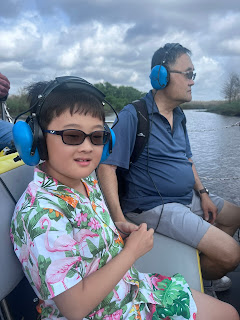Monday, April 14, 2025
Tuesday, April 8, 2025
Kicho, Inc., Quiver Biopharmaceutical and Antisense Oligonucleotide (ASO) Targets for UBE3a in the Treatment of Dup15Q Syndrome
 |
| Celebration, Florida Spring Break 2025 |
In a previous blog, I ended with a question about whatever happened to the UBE3a studies as I did not hear about any pharmaceutical companies pursuing it. Well, I found the answer and happy to report that there is a lot of interest from many parties!
Dup15q Alliance recently held a gala to raise funds for finding a cure for Dup15q Syndrome at Philadelphia and an angel donor contributed a million dollars, the most raised by a single donor for this organization. This generous donor will match future donations up to the million dollars that they already donated. The funds will be used to help two new biotech companies working to find ASO (antisense oligonucleotides) for mRNA transcription products of the UBE3a gene duplicated in the 15q 11.5-13.5 region of the syndrome.
Two new biotech companies Kicho, Inc. and Quiver Bioscience are both recipients of the raised funds from the gala to promote ASO as a potential treatment option for the syndrome. Many of the leaders of Quiver Bioscience are clinicians and researchers who had been working with people afflicted by Dup15q Syndrome and other neurodegenerative disorders. Kicho, Inc. was founded by a parent of a child afflicted with Dup15q Syndrome. How awe inspiring to find parents who redirect their life's goals to meet their children's needs.
There are multiple genes duplicated in the 15q11.2-13.1 region and preventing translation of the UBE3a mRNA sequence to its protein product may not in and of itself reverse all the symptoms of the syndrome. Inspired by how ASO's in spinal muscular atrophy completely obliterated the need for use of assistive devices during ambulation in muscular dystrophy patients, researchers at Charles River Laboratories have shown UBE3a directed ASO's completely reduced SUPEP in rat models of Dup15q Syndrome. One of the challenges a researcher stated was the complete obliteration all the UBE3a gene products versus modulation of expression to the happy medium where it would compare to that expressed in healthy brains. “Because Dup15q is a duplication case, where patients unfortunately produce excess protein, the intent is not to eliminate it but to bring it to a normal range,” said Michael V. Templin, PhD DABT, “That is an added twist to this case because it is always easier to eliminate as compared to moderate.” How will they measure what the right dosing would be? What will they be measuring against?
If obliteration of all UBE3a gene product becomes an issue why not consider an alternative pathway to normalizing the proteins targested by the ligase? Since duplication of the ubiquitin protein Ligase in Dup15q syndrome means more proteins are being tagged for degradation, would another alternative treatment option (aside from developing ASO's) be to identify and supplement the tagged proteins so that even though they are degraded more rapidly in the syndrome compared to normal brains, there will still be enough available for the brain to function normally?
There are a number of GABA receptor genes encoded in the duplicated region to consider also which I've discussed in a previous blog. Researchers are looking for drugs that would target theses gene products such as the GABAa alpha 5 negative allosteric modulator which include basmisanil and an experimental compound being researched by Saniona pharmaceuticals. Developing drugs that specifically target the duplicated region gives hope for more personalized drugs that zone in on the targeted genes responsible for a particular pathology as well as reduce off target effects. Improvements in cognition, memory and speech as so critical to support a more independent life for Lucas in the future but my immediate need right now is seizure control because on a very bad day he can have a cluster of up to 15 with added risk of injuries due to accidents from falls, especially from the head drop/ absence seizures. Kicho has partnered with Charles River Laboratories to expedite the drug discovery process as quickly as possible. " Charles River Laboratories is a global contract research organization (CRO) that provides comprehensive services to the pharmaceutical, biotechnology and medical device industries. The company offers services across the entire lifecycle of drug development, including discovery preclinical and clinical research. They are known for providing laboratory animal modes, preclinical testing, toxicology studies and other services to help companies bring new therapies to market. Charles River is also involved in supporting regulatory compliance and research to ensure the safety and efficacy of products under development". -ChatGPT
There are over 100 different ubiquitin proteasome systems in the human body but no one has found the drug that inhibits the UBE3a gene product encoded in the duplicated 15q region. It gives me hope, though, that there are several drugs already in the market that target cancer progression using a similar ubiquitin system. If a drug can be found to treat cancer by this route, why not one to treat Dup15q Syndrome?








































